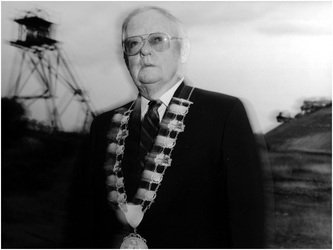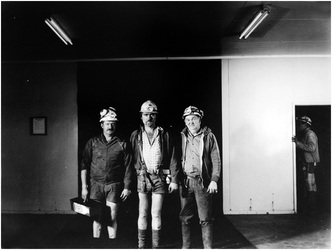A Troublesome Class of Men, Ipswich, Queensland Australia
In 1990-91 the Ipswich-West Moreton Coal fields in Queensland were ceasing underground mining operations. This series of portraits referenced the history of the mining culture (retired and retrenched miners) as well as the impact on the current workforce, many of whom were third and fourth generation miners.
In 1871 a Queensland railways official stated that “the miners generally are a troublesome class of men to deal with and frequently strike”
During the early months of 1988 I decided to find out more about these troublesome men, concentrating on the mining industry around Ipswich and west Moreton. I was interested in what had happened to the old guard and how the change in the fortunes of mining had affected the industry and the miners in a contemporary environment.
What I found were men who still followed the traditions of miners, in many cases the men I met and photographed were not the first generation to be a miner.
To spend a shift underground is to become part of a unique workforce, it’s extremely dangerous and although machines have alleviated a lot of the manual work, the working conditions are still totally unknown to most of the non-mining population. There is something comforting about long observed traditions, eating in the crib room with just the light on a hard hat to see what’s for lunch, solid lunch boxes to keep the rats out and at the end of the shift a communal shower. But most of all, it’s the comradery that has always existed amongst miners that partly explains why men are prepared to spend most of their working lives underground.
As a group they support each other and the causes of mining, the railway official was right, they are a troublesome class of men, or perhaps a class of men who know what trouble is.
In 1871 a Queensland railways official stated that “the miners generally are a troublesome class of men to deal with and frequently strike”
During the early months of 1988 I decided to find out more about these troublesome men, concentrating on the mining industry around Ipswich and west Moreton. I was interested in what had happened to the old guard and how the change in the fortunes of mining had affected the industry and the miners in a contemporary environment.
What I found were men who still followed the traditions of miners, in many cases the men I met and photographed were not the first generation to be a miner.
To spend a shift underground is to become part of a unique workforce, it’s extremely dangerous and although machines have alleviated a lot of the manual work, the working conditions are still totally unknown to most of the non-mining population. There is something comforting about long observed traditions, eating in the crib room with just the light on a hard hat to see what’s for lunch, solid lunch boxes to keep the rats out and at the end of the shift a communal shower. But most of all, it’s the comradery that has always existed amongst miners that partly explains why men are prepared to spend most of their working lives underground.
As a group they support each other and the causes of mining, the railway official was right, they are a troublesome class of men, or perhaps a class of men who know what trouble is.
Image 1 Col. Brocke, Ipswich 1988
Col. was retrenched after 34 years in the mines, he’d started mining when he was 15. Col. now works as gravedigger at the Ipswich cemetery, I’d expected him to be bitter, he wasn’t, he just missed being underground.
Anyhow, he quipped “this job isn’t all that different, I used to dig from the bottom up, now I dig from the top down”.
Image 2 Ron Murphy, Box Flat 1988
On the 31st. of July 1972, 17 miners died in the Box Flat mine. Ron was at that time a District Check Inspector, he was included in the discussions which finally led to the decision to seal the mine. Ron’s brother was one of the those still underground.
I photographed Ron in the change room at Box Flat. Most traces of the actual mine are obliterated, but the change room is still there. I’d been underground in coal mines several times, but the Box Flat change room was a chilling reminder that every time a miner goes underground, he may never see the surface again.
Image 3 Rogers family, Swanbank 1990
On March 15th. 1990 Ellen Claire Rogers was born.
By the time she grows up there won’t be any underground mines left in the Ipswich-West Moreton coalfields. Brett is a surveyor in an open cut coal mine, which represents a new direction in mining, yet some traditions remain.
I photographed Brett, Donna and Ellen in a peaceful park opposite the Swanbank power station.
Brett has a lengthy and tragic connection with mining, ”Both my grandfather and father worked in coal mines, my grandfather, now retired is 83, Ellen is named in memory of my father Lenard who was killed in the Box Flat mine disaster”. The mine was in close proximity to the Swanbank power station.
Image 4 Les Kerslake, Ebbw Vale 1989
In November 1963 Les was caught in an underground rockfall. He was pinned by a fallen beam on his left arm: Les spent the next 19 hours alone in the darkness. After his rescue his arm was amputated.
Image 5 Bill Llewellyn, Ipswich 1988
Bill was born in 1901 and went into the mines at Blackheath with his father in 1915. Bill was still involved in mining when he retired 46 years later. By then he was the vice president of the union. He had been through the turbulent political and industrial times and been a member of the communist party when such involvement was not fashionable.
Sixty years ago, Bill had a cottage built for himself and his new wife. He and his wife still sit on its verandah.
Image 6 Victor Pioch, Riverview aged care facility 1988
When I photographed him, Victor had difficulty responding to people and his surroundings. He’d been a miner most of his life, but now he’d retreated from the World and just wanted to be left alone.
Victor died August 9th. 1989
Image 7 Norman Nunn, Riverview aged care facility 1989
Norman was borne in 1895 and started mining at the age of 14 at New Chum. His father was working in the same mine. Although he was virtually bedridden, Norman recalled his mining days with great detail and affection.
Norman died September 10th. 1989
Image 8 Des Freeman, West Moreton field 1988
I had heard that the Mayor of Ipswich was an ex-miner and unionist, so Des was an obvious inclusion in the project. I arranged to meet Des out on the coalfields where he had spent much of his working life. At the appointed time he appeared, not in a car but walking with his mayoral chain in his hand.
He looked out of place, but I doubt he felt that way. His connections to mining were still very strong.
Image 9 Glenn and Desley Abrahams, Haigslea 1989
Mining has always forced men to go where the work is. With the decline in manpower requirements around Ipswich many miners, especially the younger ones, have moved on. Both of Glenn and Desley’s sons now work in the central Queensland coalfields. Glenn is still mining in West Moreton, but like miners before him his position is tenuous.
Image 10 Alan Miller, Rhonda No.1 1988
Alan worked at the Rhonda No.1 mine from 1943-46 and then form 1950 until hi retirement. As with many miners, Alan has a family tradition in mining, his father and grandfather were miners.
Rhonda No. 1 represents the classical vision of a mine, the poppet head. There are none left in operation on the West Moreton field. The characterless incline mines are cheaper to operate.
Images 11-15 Hankey mine, 1988















